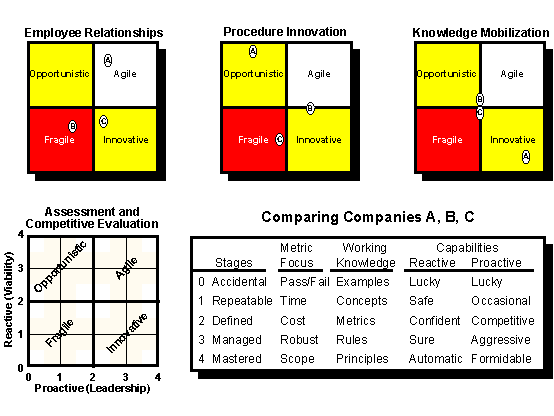 Paradigm Shift
Paradigm ShiftInternational
Agile Enterprise
Reference Model
 Paradigm Shift Paradigm ShiftInternational |
Agile Enterprise |
|
Features: Home | Library |
Corp Info |
(Section A: Part 4 of 4) In Conclusion Today it is fairly easy to hop in your car, turn on the ignition key, step on the gas and brake pedals alternatively while steering, and arrive at your destination. But before that was possible somebody had to invent and build engines, tires, roads, and a lot of other complicated stuff; and make sure that all the pieces and subsystems were compatible and functionally integrated. That’s what has happened with this reference model and case study. We had the major subsystems conceptualized [5] and even some focused case examples documented [2], but until we tried to drive it down the road we hadn’t addressed the integration and completeness issues. This is a first attempt at integrating these concepts, and it was sometimes difficult to find precise meanings and interpretations for some of the business practice areas. We invite you to view these offerings as data and enlightenment, not as science and unambiguousness. There were times when we had to stop the (team-internal) debate in the interest of getting something done. Too many of the debates were circular and recursive, not leading to any unambiguous end-point. Well, such is life. If it were absolutely straightforward with a single correct interpretation there would be little left to the contest. Like people, there is no one correct yardstick that all can be measured against, some are better at some things then others, and the permutations are infinite. At any point in time one collection of strategies may be better suited for existence in a specific environment than another, but at another time or in another place the bets are different. There are three elements in this reference "model": the first is an enterprise framework provided by the 24 critical business practices, the second offers a list of 200-plus objectives provided by the change issues, and the third gives examples of how one company, Remmele, successfully addresses most of these issues. Of the first: these 24 practices are presented as neither the only ones nor the particular ones that you might want to consider in your business, but they do provide a rich and comprehensive armature. Of the second: these 200-plus issues are not claimed to be universally appropriate; but they do provide a solid pro forma for any company to build upon. Of the third: Remmele's way is not the only way to attain change proficiency in the issues that face them—though we have come to believe that Remmele’s reliance on an ideological infrastructure is a very powerful and perhaps even optimal way. In addition to the reference model, we have included an assessment of Remmele's change proficiency maturity. We did this to discipline ourselves in the analysis and presentation of the reference model and also to verify that Remmele was in fact a role model of change proficiency. Though we have tried to make each of the critical business practice sections reasonably stand alone, they are not totally independent, else they would each have to be much longer. Thus, reading about Strategy Innovation Management assumes the reader will also read the three related practices of Strategic Plan Vision, Strategic Plan Dissemination, and Strategic Plan Buy-In, as well as the three related practices of Product Innovation Management, Process Innovation Management, and Practice/Procedure Innovation. We offer this reference model as a starting point to help you begin your own introspection. It identifies many key issues that must be addressed or at least considered when you set out to become more change proficient than you currently are. Importantly, it provides a means for competitive comparison and prioritizing improvement strategies. It also displays one company's approach to addressing most of these issues successfully. |
 |
|
|
Features: Home | Library |
Corp Info Send email to |